Research Proposal: Analyzing Training and Development Methodologies
VerifiedAdded on 2020/02/14
|13
|5063
|318
Report
AI Summary
This report presents a research proposal focused on analyzing the significance of training and development within organizations, specifically in the context of the hospitality industry. The proposal outlines the research aims and objectives, which include analyzing the importance of training, ascertaining training methods, and exploring factors generating training needs. The research methodology section details the data collection methods (secondary sources), research approach (inductive), philosophy (Interpretivism), and research design (Descriptive with Case Study). The report also addresses data analysis (Qualitative technique), potential research issues and limitations, and ethical considerations, such as data privacy and plagiarism avoidance. The overall aim is to provide a comprehensive overview of the research process, highlighting the methodologies used to explore the impact of training and development on organizational performance and productivity.
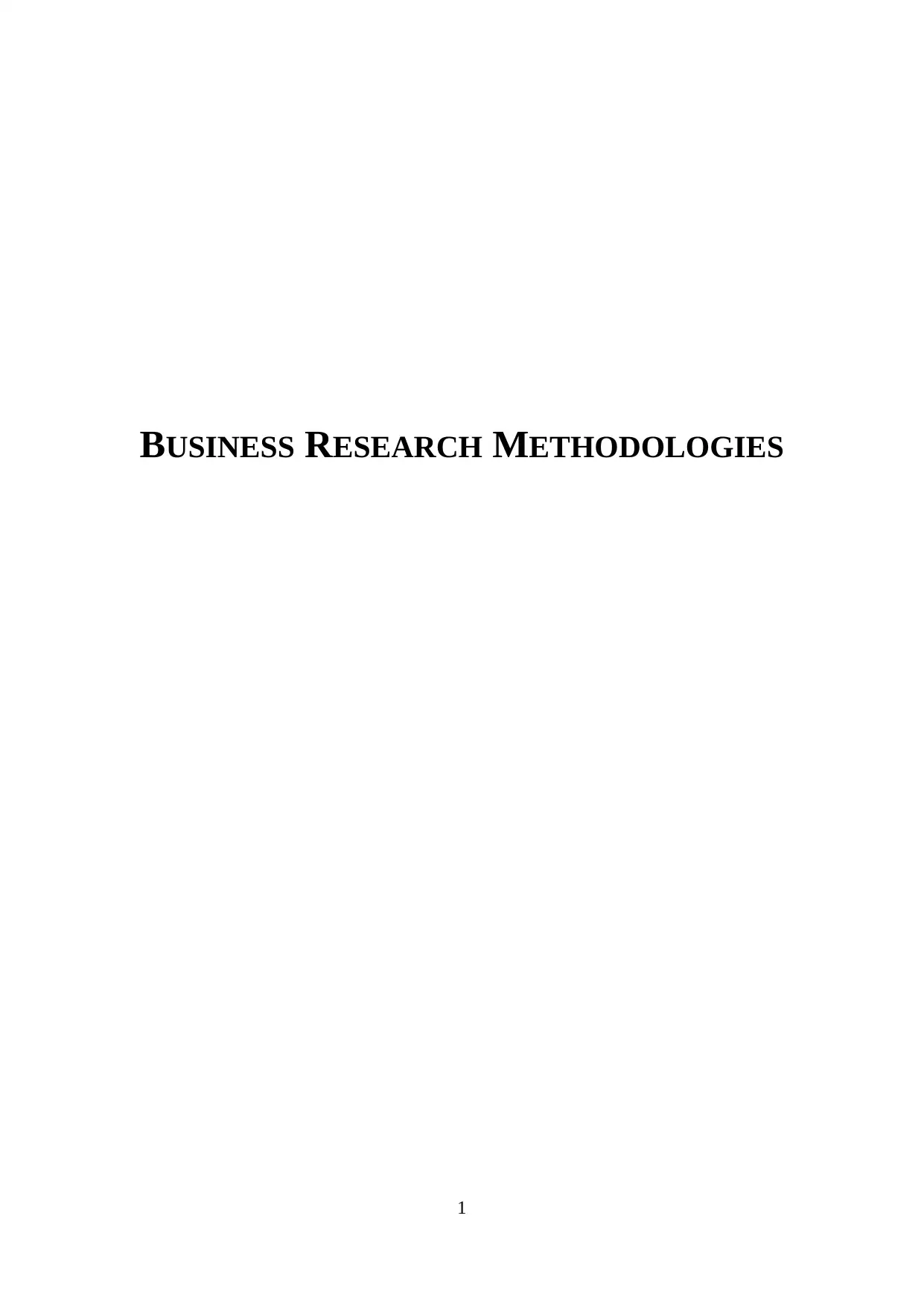
BUSINESS RESEARCH METHODOLOGIES
1
1
Paraphrase This Document
Need a fresh take? Get an instant paraphrase of this document with our AI Paraphraser
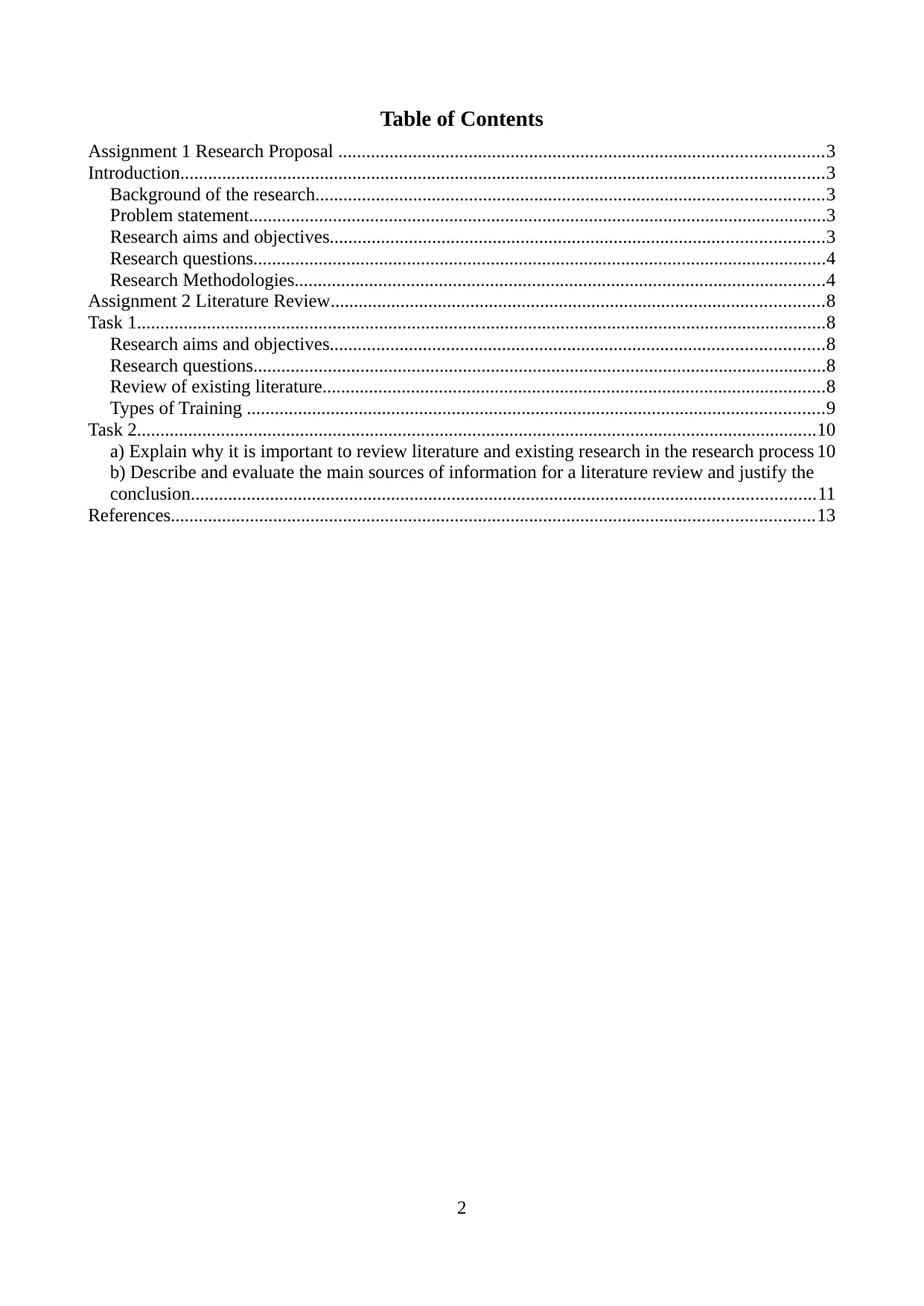
Table of Contents
Assignment 1 Research Proposal ........................................................................................................3
Introduction..........................................................................................................................................3
Background of the research.............................................................................................................3
Problem statement............................................................................................................................3
Research aims and objectives..........................................................................................................3
Research questions...........................................................................................................................4
Research Methodologies..................................................................................................................4
Assignment 2 Literature Review..........................................................................................................8
Task 1....................................................................................................................................................8
Research aims and objectives..........................................................................................................8
Research questions...........................................................................................................................8
Review of existing literature............................................................................................................8
Types of Training ............................................................................................................................9
Task 2..................................................................................................................................................10
a) Explain why it is important to review literature and existing research in the research process 10
b) Describe and evaluate the main sources of information for a literature review and justify the
conclusion......................................................................................................................................11
References..........................................................................................................................................13
2
Assignment 1 Research Proposal ........................................................................................................3
Introduction..........................................................................................................................................3
Background of the research.............................................................................................................3
Problem statement............................................................................................................................3
Research aims and objectives..........................................................................................................3
Research questions...........................................................................................................................4
Research Methodologies..................................................................................................................4
Assignment 2 Literature Review..........................................................................................................8
Task 1....................................................................................................................................................8
Research aims and objectives..........................................................................................................8
Research questions...........................................................................................................................8
Review of existing literature............................................................................................................8
Types of Training ............................................................................................................................9
Task 2..................................................................................................................................................10
a) Explain why it is important to review literature and existing research in the research process 10
b) Describe and evaluate the main sources of information for a literature review and justify the
conclusion......................................................................................................................................11
References..........................................................................................................................................13
2
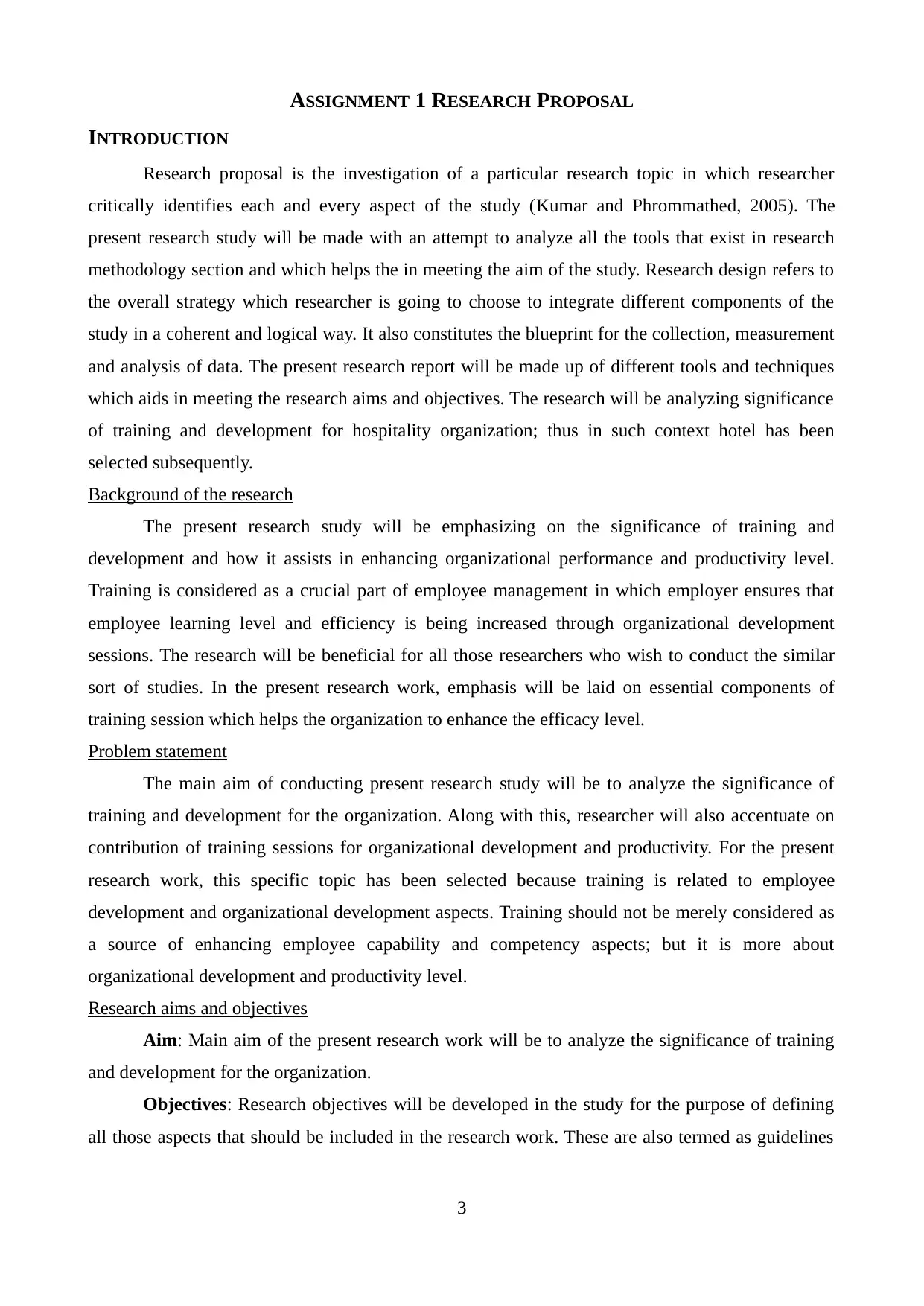
ASSIGNMENT 1 RESEARCH PROPOSAL
INTRODUCTION
Research proposal is the investigation of a particular research topic in which researcher
critically identifies each and every aspect of the study (Kumar and Phrommathed, 2005). The
present research study will be made with an attempt to analyze all the tools that exist in research
methodology section and which helps the in meeting the aim of the study. Research design refers to
the overall strategy which researcher is going to choose to integrate different components of the
study in a coherent and logical way. It also constitutes the blueprint for the collection, measurement
and analysis of data. The present research report will be made up of different tools and techniques
which aids in meeting the research aims and objectives. The research will be analyzing significance
of training and development for hospitality organization; thus in such context hotel has been
selected subsequently.
Background of the research
The present research study will be emphasizing on the significance of training and
development and how it assists in enhancing organizational performance and productivity level.
Training is considered as a crucial part of employee management in which employer ensures that
employee learning level and efficiency is being increased through organizational development
sessions. The research will be beneficial for all those researchers who wish to conduct the similar
sort of studies. In the present research work, emphasis will be laid on essential components of
training session which helps the organization to enhance the efficacy level.
Problem statement
The main aim of conducting present research study will be to analyze the significance of
training and development for the organization. Along with this, researcher will also accentuate on
contribution of training sessions for organizational development and productivity. For the present
research work, this specific topic has been selected because training is related to employee
development and organizational development aspects. Training should not be merely considered as
a source of enhancing employee capability and competency aspects; but it is more about
organizational development and productivity level.
Research aims and objectives
Aim: Main aim of the present research work will be to analyze the significance of training
and development for the organization.
Objectives: Research objectives will be developed in the study for the purpose of defining
all those aspects that should be included in the research work. These are also termed as guidelines
3
INTRODUCTION
Research proposal is the investigation of a particular research topic in which researcher
critically identifies each and every aspect of the study (Kumar and Phrommathed, 2005). The
present research study will be made with an attempt to analyze all the tools that exist in research
methodology section and which helps the in meeting the aim of the study. Research design refers to
the overall strategy which researcher is going to choose to integrate different components of the
study in a coherent and logical way. It also constitutes the blueprint for the collection, measurement
and analysis of data. The present research report will be made up of different tools and techniques
which aids in meeting the research aims and objectives. The research will be analyzing significance
of training and development for hospitality organization; thus in such context hotel has been
selected subsequently.
Background of the research
The present research study will be emphasizing on the significance of training and
development and how it assists in enhancing organizational performance and productivity level.
Training is considered as a crucial part of employee management in which employer ensures that
employee learning level and efficiency is being increased through organizational development
sessions. The research will be beneficial for all those researchers who wish to conduct the similar
sort of studies. In the present research work, emphasis will be laid on essential components of
training session which helps the organization to enhance the efficacy level.
Problem statement
The main aim of conducting present research study will be to analyze the significance of
training and development for the organization. Along with this, researcher will also accentuate on
contribution of training sessions for organizational development and productivity. For the present
research work, this specific topic has been selected because training is related to employee
development and organizational development aspects. Training should not be merely considered as
a source of enhancing employee capability and competency aspects; but it is more about
organizational development and productivity level.
Research aims and objectives
Aim: Main aim of the present research work will be to analyze the significance of training
and development for the organization.
Objectives: Research objectives will be developed in the study for the purpose of defining
all those aspects that should be included in the research work. These are also termed as guidelines
3
⊘ This is a preview!⊘
Do you want full access?
Subscribe today to unlock all pages.

Trusted by 1+ million students worldwide
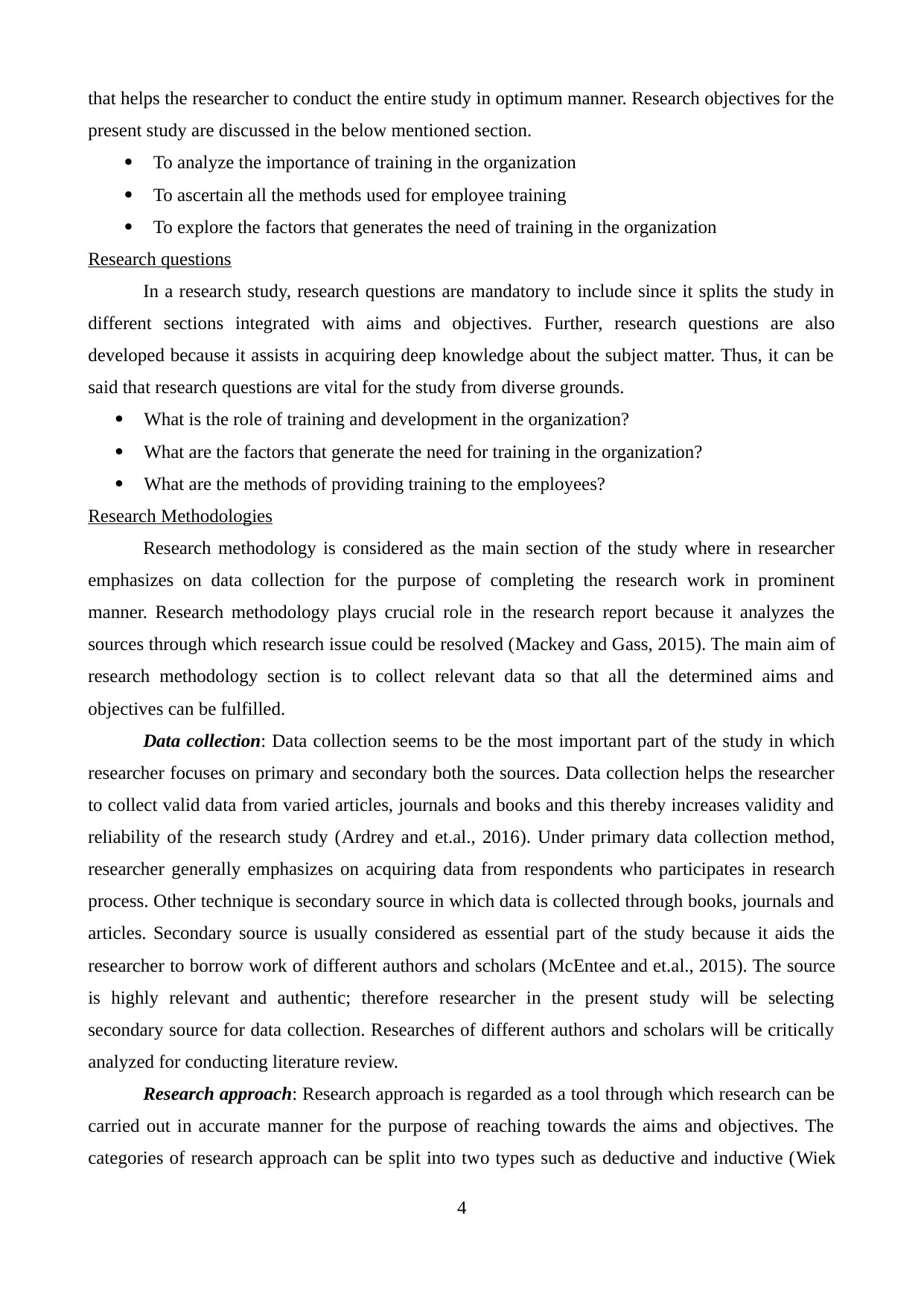
that helps the researcher to conduct the entire study in optimum manner. Research objectives for the
present study are discussed in the below mentioned section.
To analyze the importance of training in the organization
To ascertain all the methods used for employee training
To explore the factors that generates the need of training in the organization
Research questions
In a research study, research questions are mandatory to include since it splits the study in
different sections integrated with aims and objectives. Further, research questions are also
developed because it assists in acquiring deep knowledge about the subject matter. Thus, it can be
said that research questions are vital for the study from diverse grounds.
What is the role of training and development in the organization?
What are the factors that generate the need for training in the organization?
What are the methods of providing training to the employees?
Research Methodologies
Research methodology is considered as the main section of the study where in researcher
emphasizes on data collection for the purpose of completing the research work in prominent
manner. Research methodology plays crucial role in the research report because it analyzes the
sources through which research issue could be resolved (Mackey and Gass, 2015). The main aim of
research methodology section is to collect relevant data so that all the determined aims and
objectives can be fulfilled.
Data collection: Data collection seems to be the most important part of the study in which
researcher focuses on primary and secondary both the sources. Data collection helps the researcher
to collect valid data from varied articles, journals and books and this thereby increases validity and
reliability of the research study (Ardrey and et.al., 2016). Under primary data collection method,
researcher generally emphasizes on acquiring data from respondents who participates in research
process. Other technique is secondary source in which data is collected through books, journals and
articles. Secondary source is usually considered as essential part of the study because it aids the
researcher to borrow work of different authors and scholars (McEntee and et.al., 2015). The source
is highly relevant and authentic; therefore researcher in the present study will be selecting
secondary source for data collection. Researches of different authors and scholars will be critically
analyzed for conducting literature review.
Research approach: Research approach is regarded as a tool through which research can be
carried out in accurate manner for the purpose of reaching towards the aims and objectives. The
categories of research approach can be split into two types such as deductive and inductive (Wiek
4
present study are discussed in the below mentioned section.
To analyze the importance of training in the organization
To ascertain all the methods used for employee training
To explore the factors that generates the need of training in the organization
Research questions
In a research study, research questions are mandatory to include since it splits the study in
different sections integrated with aims and objectives. Further, research questions are also
developed because it assists in acquiring deep knowledge about the subject matter. Thus, it can be
said that research questions are vital for the study from diverse grounds.
What is the role of training and development in the organization?
What are the factors that generate the need for training in the organization?
What are the methods of providing training to the employees?
Research Methodologies
Research methodology is considered as the main section of the study where in researcher
emphasizes on data collection for the purpose of completing the research work in prominent
manner. Research methodology plays crucial role in the research report because it analyzes the
sources through which research issue could be resolved (Mackey and Gass, 2015). The main aim of
research methodology section is to collect relevant data so that all the determined aims and
objectives can be fulfilled.
Data collection: Data collection seems to be the most important part of the study in which
researcher focuses on primary and secondary both the sources. Data collection helps the researcher
to collect valid data from varied articles, journals and books and this thereby increases validity and
reliability of the research study (Ardrey and et.al., 2016). Under primary data collection method,
researcher generally emphasizes on acquiring data from respondents who participates in research
process. Other technique is secondary source in which data is collected through books, journals and
articles. Secondary source is usually considered as essential part of the study because it aids the
researcher to borrow work of different authors and scholars (McEntee and et.al., 2015). The source
is highly relevant and authentic; therefore researcher in the present study will be selecting
secondary source for data collection. Researches of different authors and scholars will be critically
analyzed for conducting literature review.
Research approach: Research approach is regarded as a tool through which research can be
carried out in accurate manner for the purpose of reaching towards the aims and objectives. The
categories of research approach can be split into two types such as deductive and inductive (Wiek
4
Paraphrase This Document
Need a fresh take? Get an instant paraphrase of this document with our AI Paraphraser
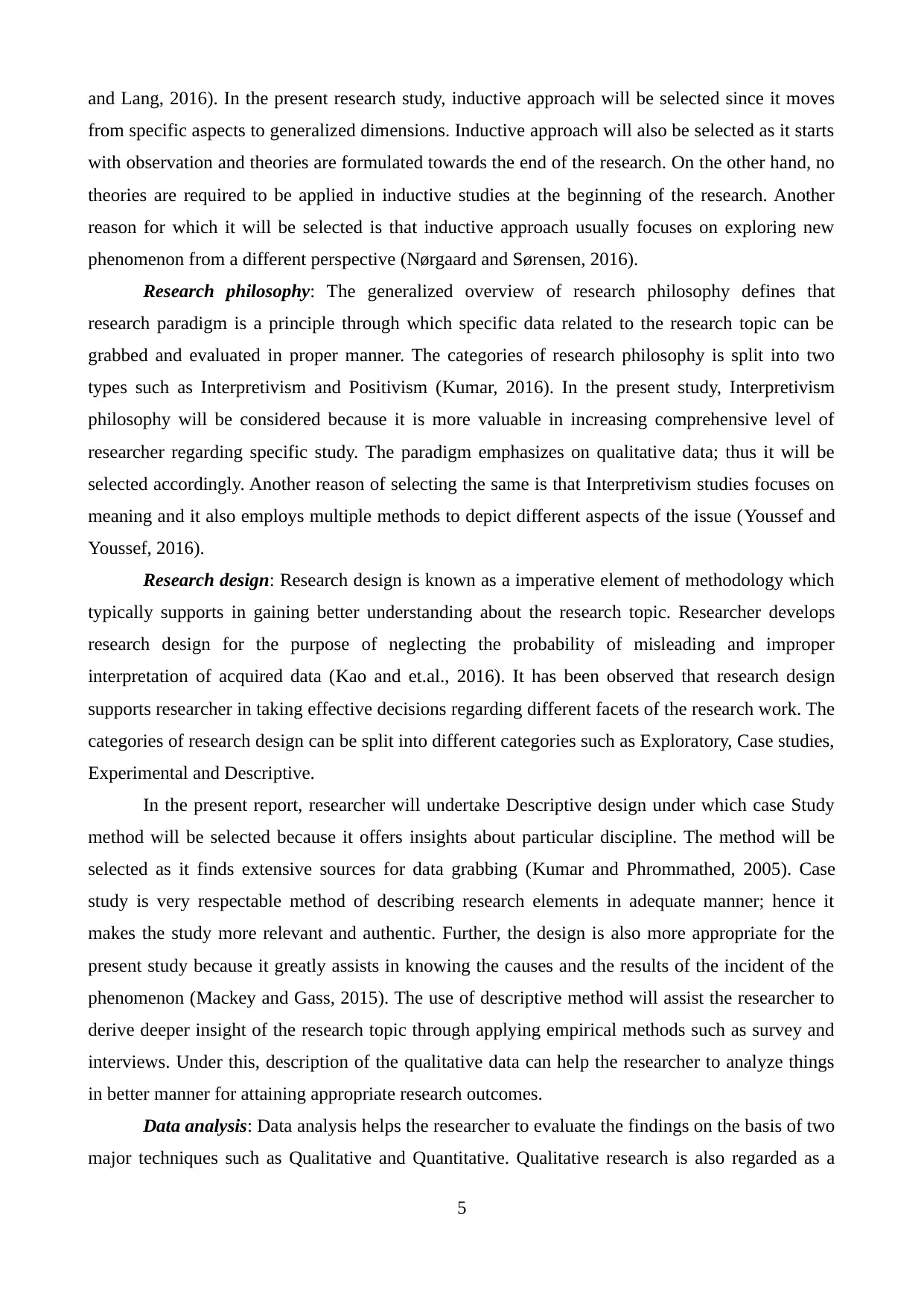
and Lang, 2016). In the present research study, inductive approach will be selected since it moves
from specific aspects to generalized dimensions. Inductive approach will also be selected as it starts
with observation and theories are formulated towards the end of the research. On the other hand, no
theories are required to be applied in inductive studies at the beginning of the research. Another
reason for which it will be selected is that inductive approach usually focuses on exploring new
phenomenon from a different perspective (Nørgaard and Sørensen, 2016).
Research philosophy: The generalized overview of research philosophy defines that
research paradigm is a principle through which specific data related to the research topic can be
grabbed and evaluated in proper manner. The categories of research philosophy is split into two
types such as Interpretivism and Positivism (Kumar, 2016). In the present study, Interpretivism
philosophy will be considered because it is more valuable in increasing comprehensive level of
researcher regarding specific study. The paradigm emphasizes on qualitative data; thus it will be
selected accordingly. Another reason of selecting the same is that Interpretivism studies focuses on
meaning and it also employs multiple methods to depict different aspects of the issue (Youssef and
Youssef, 2016).
Research design: Research design is known as a imperative element of methodology which
typically supports in gaining better understanding about the research topic. Researcher develops
research design for the purpose of neglecting the probability of misleading and improper
interpretation of acquired data (Kao and et.al., 2016). It has been observed that research design
supports researcher in taking effective decisions regarding different facets of the research work. The
categories of research design can be split into different categories such as Exploratory, Case studies,
Experimental and Descriptive.
In the present report, researcher will undertake Descriptive design under which case Study
method will be selected because it offers insights about particular discipline. The method will be
selected as it finds extensive sources for data grabbing (Kumar and Phrommathed, 2005). Case
study is very respectable method of describing research elements in adequate manner; hence it
makes the study more relevant and authentic. Further, the design is also more appropriate for the
present study because it greatly assists in knowing the causes and the results of the incident of the
phenomenon (Mackey and Gass, 2015). The use of descriptive method will assist the researcher to
derive deeper insight of the research topic through applying empirical methods such as survey and
interviews. Under this, description of the qualitative data can help the researcher to analyze things
in better manner for attaining appropriate research outcomes.
Data analysis: Data analysis helps the researcher to evaluate the findings on the basis of two
major techniques such as Qualitative and Quantitative. Qualitative research is also regarded as a
5
from specific aspects to generalized dimensions. Inductive approach will also be selected as it starts
with observation and theories are formulated towards the end of the research. On the other hand, no
theories are required to be applied in inductive studies at the beginning of the research. Another
reason for which it will be selected is that inductive approach usually focuses on exploring new
phenomenon from a different perspective (Nørgaard and Sørensen, 2016).
Research philosophy: The generalized overview of research philosophy defines that
research paradigm is a principle through which specific data related to the research topic can be
grabbed and evaluated in proper manner. The categories of research philosophy is split into two
types such as Interpretivism and Positivism (Kumar, 2016). In the present study, Interpretivism
philosophy will be considered because it is more valuable in increasing comprehensive level of
researcher regarding specific study. The paradigm emphasizes on qualitative data; thus it will be
selected accordingly. Another reason of selecting the same is that Interpretivism studies focuses on
meaning and it also employs multiple methods to depict different aspects of the issue (Youssef and
Youssef, 2016).
Research design: Research design is known as a imperative element of methodology which
typically supports in gaining better understanding about the research topic. Researcher develops
research design for the purpose of neglecting the probability of misleading and improper
interpretation of acquired data (Kao and et.al., 2016). It has been observed that research design
supports researcher in taking effective decisions regarding different facets of the research work. The
categories of research design can be split into different categories such as Exploratory, Case studies,
Experimental and Descriptive.
In the present report, researcher will undertake Descriptive design under which case Study
method will be selected because it offers insights about particular discipline. The method will be
selected as it finds extensive sources for data grabbing (Kumar and Phrommathed, 2005). Case
study is very respectable method of describing research elements in adequate manner; hence it
makes the study more relevant and authentic. Further, the design is also more appropriate for the
present study because it greatly assists in knowing the causes and the results of the incident of the
phenomenon (Mackey and Gass, 2015). The use of descriptive method will assist the researcher to
derive deeper insight of the research topic through applying empirical methods such as survey and
interviews. Under this, description of the qualitative data can help the researcher to analyze things
in better manner for attaining appropriate research outcomes.
Data analysis: Data analysis helps the researcher to evaluate the findings on the basis of two
major techniques such as Qualitative and Quantitative. Qualitative research is also regarded as a
5
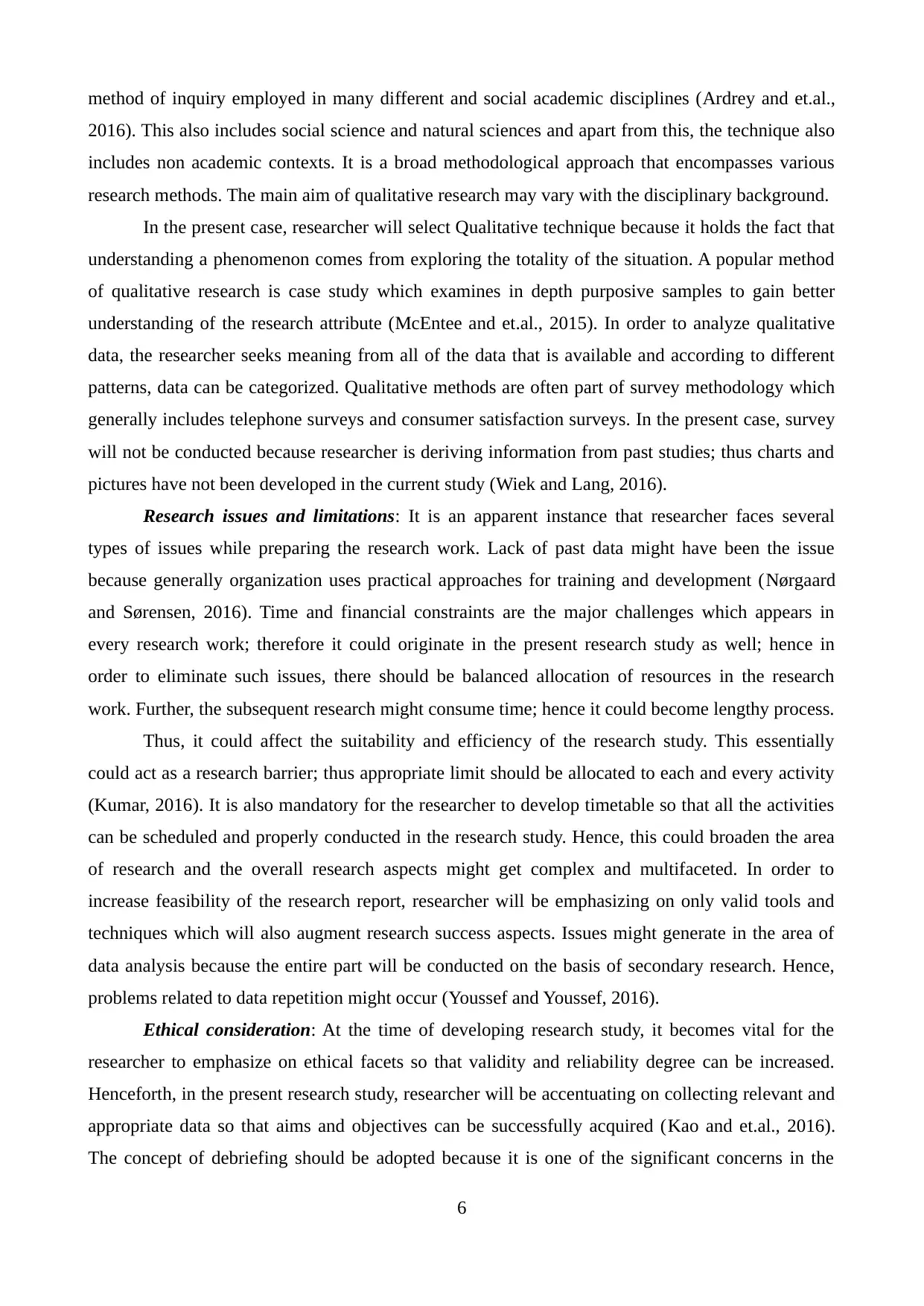
method of inquiry employed in many different and social academic disciplines (Ardrey and et.al.,
2016). This also includes social science and natural sciences and apart from this, the technique also
includes non academic contexts. It is a broad methodological approach that encompasses various
research methods. The main aim of qualitative research may vary with the disciplinary background.
In the present case, researcher will select Qualitative technique because it holds the fact that
understanding a phenomenon comes from exploring the totality of the situation. A popular method
of qualitative research is case study which examines in depth purposive samples to gain better
understanding of the research attribute (McEntee and et.al., 2015). In order to analyze qualitative
data, the researcher seeks meaning from all of the data that is available and according to different
patterns, data can be categorized. Qualitative methods are often part of survey methodology which
generally includes telephone surveys and consumer satisfaction surveys. In the present case, survey
will not be conducted because researcher is deriving information from past studies; thus charts and
pictures have not been developed in the current study (Wiek and Lang, 2016).
Research issues and limitations: It is an apparent instance that researcher faces several
types of issues while preparing the research work. Lack of past data might have been the issue
because generally organization uses practical approaches for training and development (Nørgaard
and Sørensen, 2016). Time and financial constraints are the major challenges which appears in
every research work; therefore it could originate in the present research study as well; hence in
order to eliminate such issues, there should be balanced allocation of resources in the research
work. Further, the subsequent research might consume time; hence it could become lengthy process.
Thus, it could affect the suitability and efficiency of the research study. This essentially
could act as a research barrier; thus appropriate limit should be allocated to each and every activity
(Kumar, 2016). It is also mandatory for the researcher to develop timetable so that all the activities
can be scheduled and properly conducted in the research study. Hence, this could broaden the area
of research and the overall research aspects might get complex and multifaceted. In order to
increase feasibility of the research report, researcher will be emphasizing on only valid tools and
techniques which will also augment research success aspects. Issues might generate in the area of
data analysis because the entire part will be conducted on the basis of secondary research. Hence,
problems related to data repetition might occur (Youssef and Youssef, 2016).
Ethical consideration: At the time of developing research study, it becomes vital for the
researcher to emphasize on ethical facets so that validity and reliability degree can be increased.
Henceforth, in the present research study, researcher will be accentuating on collecting relevant and
appropriate data so that aims and objectives can be successfully acquired (Kao and et.al., 2016).
The concept of debriefing should be adopted because it is one of the significant concerns in the
6
2016). This also includes social science and natural sciences and apart from this, the technique also
includes non academic contexts. It is a broad methodological approach that encompasses various
research methods. The main aim of qualitative research may vary with the disciplinary background.
In the present case, researcher will select Qualitative technique because it holds the fact that
understanding a phenomenon comes from exploring the totality of the situation. A popular method
of qualitative research is case study which examines in depth purposive samples to gain better
understanding of the research attribute (McEntee and et.al., 2015). In order to analyze qualitative
data, the researcher seeks meaning from all of the data that is available and according to different
patterns, data can be categorized. Qualitative methods are often part of survey methodology which
generally includes telephone surveys and consumer satisfaction surveys. In the present case, survey
will not be conducted because researcher is deriving information from past studies; thus charts and
pictures have not been developed in the current study (Wiek and Lang, 2016).
Research issues and limitations: It is an apparent instance that researcher faces several
types of issues while preparing the research work. Lack of past data might have been the issue
because generally organization uses practical approaches for training and development (Nørgaard
and Sørensen, 2016). Time and financial constraints are the major challenges which appears in
every research work; therefore it could originate in the present research study as well; hence in
order to eliminate such issues, there should be balanced allocation of resources in the research
work. Further, the subsequent research might consume time; hence it could become lengthy process.
Thus, it could affect the suitability and efficiency of the research study. This essentially
could act as a research barrier; thus appropriate limit should be allocated to each and every activity
(Kumar, 2016). It is also mandatory for the researcher to develop timetable so that all the activities
can be scheduled and properly conducted in the research study. Hence, this could broaden the area
of research and the overall research aspects might get complex and multifaceted. In order to
increase feasibility of the research report, researcher will be emphasizing on only valid tools and
techniques which will also augment research success aspects. Issues might generate in the area of
data analysis because the entire part will be conducted on the basis of secondary research. Hence,
problems related to data repetition might occur (Youssef and Youssef, 2016).
Ethical consideration: At the time of developing research study, it becomes vital for the
researcher to emphasize on ethical facets so that validity and reliability degree can be increased.
Henceforth, in the present research study, researcher will be accentuating on collecting relevant and
appropriate data so that aims and objectives can be successfully acquired (Kao and et.al., 2016).
The concept of debriefing should be adopted because it is one of the significant concerns in the
6
⊘ This is a preview!⊘
Do you want full access?
Subscribe today to unlock all pages.

Trusted by 1+ million students worldwide
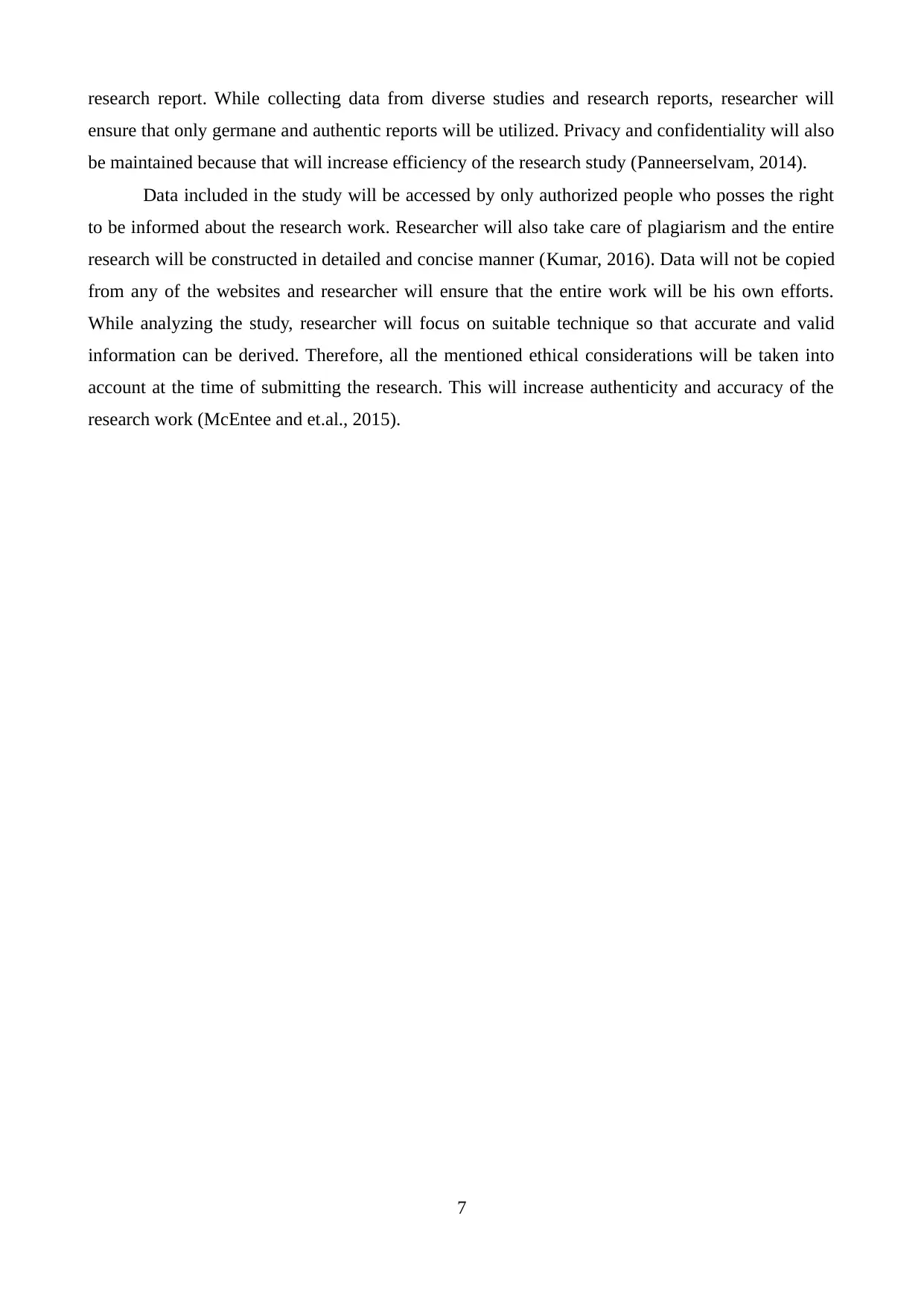
research report. While collecting data from diverse studies and research reports, researcher will
ensure that only germane and authentic reports will be utilized. Privacy and confidentiality will also
be maintained because that will increase efficiency of the research study (Panneerselvam, 2014).
Data included in the study will be accessed by only authorized people who posses the right
to be informed about the research work. Researcher will also take care of plagiarism and the entire
research will be constructed in detailed and concise manner (Kumar, 2016). Data will not be copied
from any of the websites and researcher will ensure that the entire work will be his own efforts.
While analyzing the study, researcher will focus on suitable technique so that accurate and valid
information can be derived. Therefore, all the mentioned ethical considerations will be taken into
account at the time of submitting the research. This will increase authenticity and accuracy of the
research work (McEntee and et.al., 2015).
7
ensure that only germane and authentic reports will be utilized. Privacy and confidentiality will also
be maintained because that will increase efficiency of the research study (Panneerselvam, 2014).
Data included in the study will be accessed by only authorized people who posses the right
to be informed about the research work. Researcher will also take care of plagiarism and the entire
research will be constructed in detailed and concise manner (Kumar, 2016). Data will not be copied
from any of the websites and researcher will ensure that the entire work will be his own efforts.
While analyzing the study, researcher will focus on suitable technique so that accurate and valid
information can be derived. Therefore, all the mentioned ethical considerations will be taken into
account at the time of submitting the research. This will increase authenticity and accuracy of the
research work (McEntee and et.al., 2015).
7
Paraphrase This Document
Need a fresh take? Get an instant paraphrase of this document with our AI Paraphraser
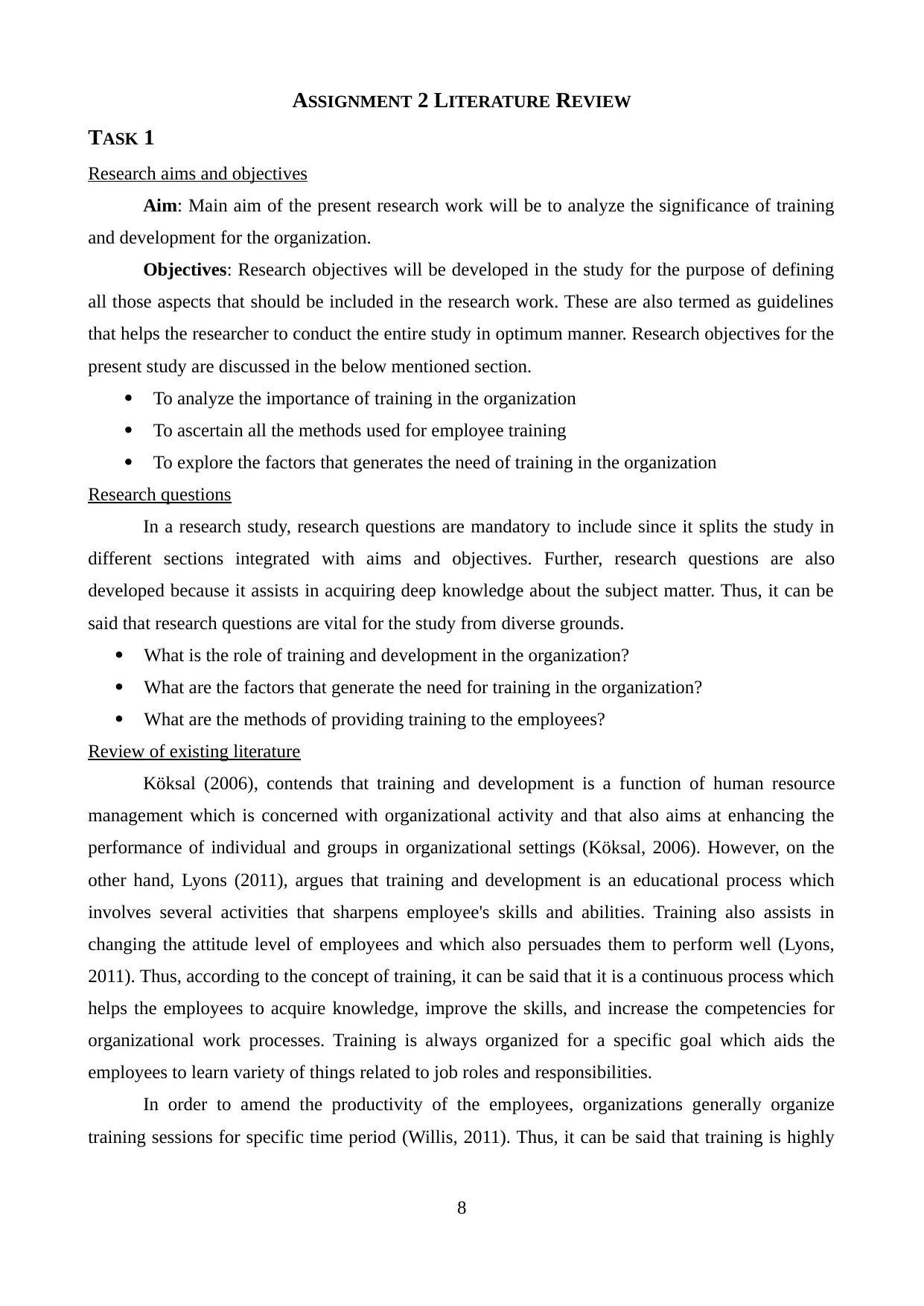
ASSIGNMENT 2 LITERATURE REVIEW
TASK 1
Research aims and objectives
Aim: Main aim of the present research work will be to analyze the significance of training
and development for the organization.
Objectives: Research objectives will be developed in the study for the purpose of defining
all those aspects that should be included in the research work. These are also termed as guidelines
that helps the researcher to conduct the entire study in optimum manner. Research objectives for the
present study are discussed in the below mentioned section.
To analyze the importance of training in the organization
To ascertain all the methods used for employee training
To explore the factors that generates the need of training in the organization
Research questions
In a research study, research questions are mandatory to include since it splits the study in
different sections integrated with aims and objectives. Further, research questions are also
developed because it assists in acquiring deep knowledge about the subject matter. Thus, it can be
said that research questions are vital for the study from diverse grounds.
What is the role of training and development in the organization?
What are the factors that generate the need for training in the organization?
What are the methods of providing training to the employees?
Review of existing literature
Köksal (2006), contends that training and development is a function of human resource
management which is concerned with organizational activity and that also aims at enhancing the
performance of individual and groups in organizational settings (Köksal, 2006). However, on the
other hand, Lyons (2011), argues that training and development is an educational process which
involves several activities that sharpens employee's skills and abilities. Training also assists in
changing the attitude level of employees and which also persuades them to perform well (Lyons,
2011). Thus, according to the concept of training, it can be said that it is a continuous process which
helps the employees to acquire knowledge, improve the skills, and increase the competencies for
organizational work processes. Training is always organized for a specific goal which aids the
employees to learn variety of things related to job roles and responsibilities.
In order to amend the productivity of the employees, organizations generally organize
training sessions for specific time period (Willis, 2011). Thus, it can be said that training is highly
8
TASK 1
Research aims and objectives
Aim: Main aim of the present research work will be to analyze the significance of training
and development for the organization.
Objectives: Research objectives will be developed in the study for the purpose of defining
all those aspects that should be included in the research work. These are also termed as guidelines
that helps the researcher to conduct the entire study in optimum manner. Research objectives for the
present study are discussed in the below mentioned section.
To analyze the importance of training in the organization
To ascertain all the methods used for employee training
To explore the factors that generates the need of training in the organization
Research questions
In a research study, research questions are mandatory to include since it splits the study in
different sections integrated with aims and objectives. Further, research questions are also
developed because it assists in acquiring deep knowledge about the subject matter. Thus, it can be
said that research questions are vital for the study from diverse grounds.
What is the role of training and development in the organization?
What are the factors that generate the need for training in the organization?
What are the methods of providing training to the employees?
Review of existing literature
Köksal (2006), contends that training and development is a function of human resource
management which is concerned with organizational activity and that also aims at enhancing the
performance of individual and groups in organizational settings (Köksal, 2006). However, on the
other hand, Lyons (2011), argues that training and development is an educational process which
involves several activities that sharpens employee's skills and abilities. Training also assists in
changing the attitude level of employees and which also persuades them to perform well (Lyons,
2011). Thus, according to the concept of training, it can be said that it is a continuous process which
helps the employees to acquire knowledge, improve the skills, and increase the competencies for
organizational work processes. Training is always organized for a specific goal which aids the
employees to learn variety of things related to job roles and responsibilities.
In order to amend the productivity of the employees, organizations generally organize
training sessions for specific time period (Willis, 2011). Thus, it can be said that training is highly
8
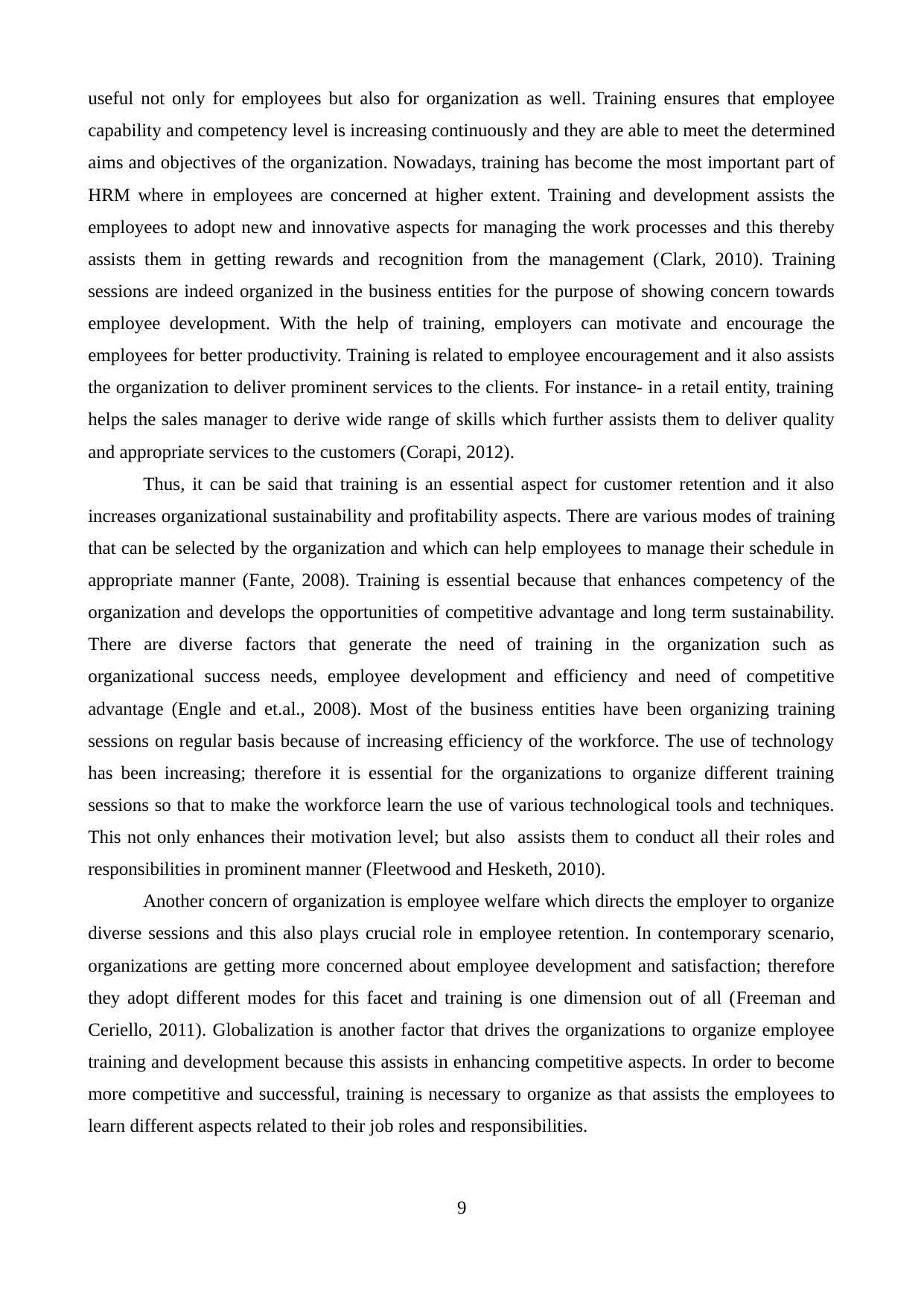
useful not only for employees but also for organization as well. Training ensures that employee
capability and competency level is increasing continuously and they are able to meet the determined
aims and objectives of the organization. Nowadays, training has become the most important part of
HRM where in employees are concerned at higher extent. Training and development assists the
employees to adopt new and innovative aspects for managing the work processes and this thereby
assists them in getting rewards and recognition from the management (Clark, 2010). Training
sessions are indeed organized in the business entities for the purpose of showing concern towards
employee development. With the help of training, employers can motivate and encourage the
employees for better productivity. Training is related to employee encouragement and it also assists
the organization to deliver prominent services to the clients. For instance- in a retail entity, training
helps the sales manager to derive wide range of skills which further assists them to deliver quality
and appropriate services to the customers (Corapi, 2012).
Thus, it can be said that training is an essential aspect for customer retention and it also
increases organizational sustainability and profitability aspects. There are various modes of training
that can be selected by the organization and which can help employees to manage their schedule in
appropriate manner (Fante, 2008). Training is essential because that enhances competency of the
organization and develops the opportunities of competitive advantage and long term sustainability.
There are diverse factors that generate the need of training in the organization such as
organizational success needs, employee development and efficiency and need of competitive
advantage (Engle and et.al., 2008). Most of the business entities have been organizing training
sessions on regular basis because of increasing efficiency of the workforce. The use of technology
has been increasing; therefore it is essential for the organizations to organize different training
sessions so that to make the workforce learn the use of various technological tools and techniques.
This not only enhances their motivation level; but also assists them to conduct all their roles and
responsibilities in prominent manner (Fleetwood and Hesketh, 2010).
Another concern of organization is employee welfare which directs the employer to organize
diverse sessions and this also plays crucial role in employee retention. In contemporary scenario,
organizations are getting more concerned about employee development and satisfaction; therefore
they adopt different modes for this facet and training is one dimension out of all (Freeman and
Ceriello, 2011). Globalization is another factor that drives the organizations to organize employee
training and development because this assists in enhancing competitive aspects. In order to become
more competitive and successful, training is necessary to organize as that assists the employees to
learn different aspects related to their job roles and responsibilities.
9
capability and competency level is increasing continuously and they are able to meet the determined
aims and objectives of the organization. Nowadays, training has become the most important part of
HRM where in employees are concerned at higher extent. Training and development assists the
employees to adopt new and innovative aspects for managing the work processes and this thereby
assists them in getting rewards and recognition from the management (Clark, 2010). Training
sessions are indeed organized in the business entities for the purpose of showing concern towards
employee development. With the help of training, employers can motivate and encourage the
employees for better productivity. Training is related to employee encouragement and it also assists
the organization to deliver prominent services to the clients. For instance- in a retail entity, training
helps the sales manager to derive wide range of skills which further assists them to deliver quality
and appropriate services to the customers (Corapi, 2012).
Thus, it can be said that training is an essential aspect for customer retention and it also
increases organizational sustainability and profitability aspects. There are various modes of training
that can be selected by the organization and which can help employees to manage their schedule in
appropriate manner (Fante, 2008). Training is essential because that enhances competency of the
organization and develops the opportunities of competitive advantage and long term sustainability.
There are diverse factors that generate the need of training in the organization such as
organizational success needs, employee development and efficiency and need of competitive
advantage (Engle and et.al., 2008). Most of the business entities have been organizing training
sessions on regular basis because of increasing efficiency of the workforce. The use of technology
has been increasing; therefore it is essential for the organizations to organize different training
sessions so that to make the workforce learn the use of various technological tools and techniques.
This not only enhances their motivation level; but also assists them to conduct all their roles and
responsibilities in prominent manner (Fleetwood and Hesketh, 2010).
Another concern of organization is employee welfare which directs the employer to organize
diverse sessions and this also plays crucial role in employee retention. In contemporary scenario,
organizations are getting more concerned about employee development and satisfaction; therefore
they adopt different modes for this facet and training is one dimension out of all (Freeman and
Ceriello, 2011). Globalization is another factor that drives the organizations to organize employee
training and development because this assists in enhancing competitive aspects. In order to become
more competitive and successful, training is necessary to organize as that assists the employees to
learn different aspects related to their job roles and responsibilities.
9
⊘ This is a preview!⊘
Do you want full access?
Subscribe today to unlock all pages.

Trusted by 1+ million students worldwide
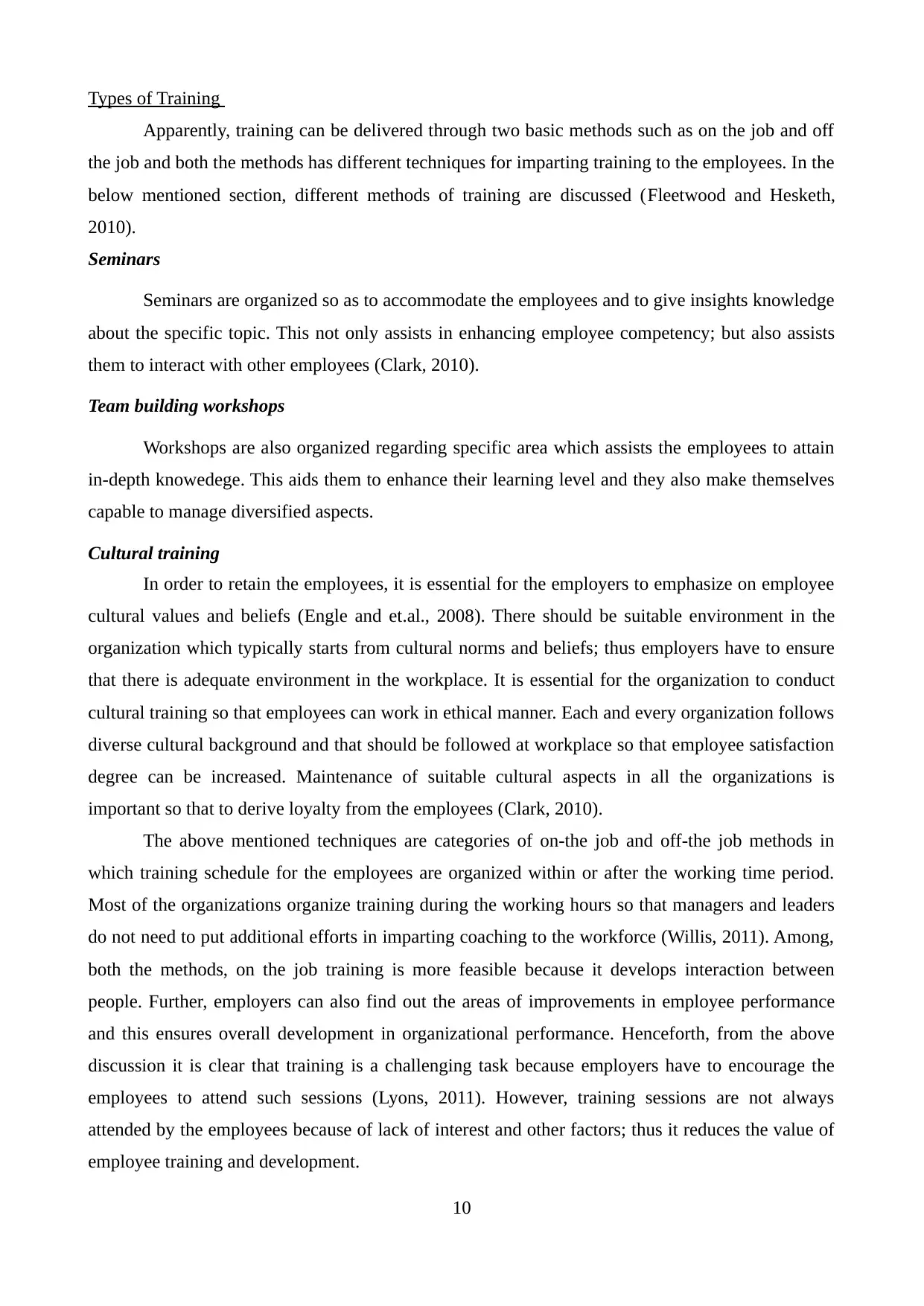
Types of Training
Apparently, training can be delivered through two basic methods such as on the job and off
the job and both the methods has different techniques for imparting training to the employees. In the
below mentioned section, different methods of training are discussed (Fleetwood and Hesketh,
2010).
Seminars
Seminars are organized so as to accommodate the employees and to give insights knowledge
about the specific topic. This not only assists in enhancing employee competency; but also assists
them to interact with other employees (Clark, 2010).
Team building workshops
Workshops are also organized regarding specific area which assists the employees to attain
in-depth knowedege. This aids them to enhance their learning level and they also make themselves
capable to manage diversified aspects.
Cultural training
In order to retain the employees, it is essential for the employers to emphasize on employee
cultural values and beliefs (Engle and et.al., 2008). There should be suitable environment in the
organization which typically starts from cultural norms and beliefs; thus employers have to ensure
that there is adequate environment in the workplace. It is essential for the organization to conduct
cultural training so that employees can work in ethical manner. Each and every organization follows
diverse cultural background and that should be followed at workplace so that employee satisfaction
degree can be increased. Maintenance of suitable cultural aspects in all the organizations is
important so that to derive loyalty from the employees (Clark, 2010).
The above mentioned techniques are categories of on-the job and off-the job methods in
which training schedule for the employees are organized within or after the working time period.
Most of the organizations organize training during the working hours so that managers and leaders
do not need to put additional efforts in imparting coaching to the workforce (Willis, 2011). Among,
both the methods, on the job training is more feasible because it develops interaction between
people. Further, employers can also find out the areas of improvements in employee performance
and this ensures overall development in organizational performance. Henceforth, from the above
discussion it is clear that training is a challenging task because employers have to encourage the
employees to attend such sessions (Lyons, 2011). However, training sessions are not always
attended by the employees because of lack of interest and other factors; thus it reduces the value of
employee training and development.
10
Apparently, training can be delivered through two basic methods such as on the job and off
the job and both the methods has different techniques for imparting training to the employees. In the
below mentioned section, different methods of training are discussed (Fleetwood and Hesketh,
2010).
Seminars
Seminars are organized so as to accommodate the employees and to give insights knowledge
about the specific topic. This not only assists in enhancing employee competency; but also assists
them to interact with other employees (Clark, 2010).
Team building workshops
Workshops are also organized regarding specific area which assists the employees to attain
in-depth knowedege. This aids them to enhance their learning level and they also make themselves
capable to manage diversified aspects.
Cultural training
In order to retain the employees, it is essential for the employers to emphasize on employee
cultural values and beliefs (Engle and et.al., 2008). There should be suitable environment in the
organization which typically starts from cultural norms and beliefs; thus employers have to ensure
that there is adequate environment in the workplace. It is essential for the organization to conduct
cultural training so that employees can work in ethical manner. Each and every organization follows
diverse cultural background and that should be followed at workplace so that employee satisfaction
degree can be increased. Maintenance of suitable cultural aspects in all the organizations is
important so that to derive loyalty from the employees (Clark, 2010).
The above mentioned techniques are categories of on-the job and off-the job methods in
which training schedule for the employees are organized within or after the working time period.
Most of the organizations organize training during the working hours so that managers and leaders
do not need to put additional efforts in imparting coaching to the workforce (Willis, 2011). Among,
both the methods, on the job training is more feasible because it develops interaction between
people. Further, employers can also find out the areas of improvements in employee performance
and this ensures overall development in organizational performance. Henceforth, from the above
discussion it is clear that training is a challenging task because employers have to encourage the
employees to attend such sessions (Lyons, 2011). However, training sessions are not always
attended by the employees because of lack of interest and other factors; thus it reduces the value of
employee training and development.
10
Paraphrase This Document
Need a fresh take? Get an instant paraphrase of this document with our AI Paraphraser
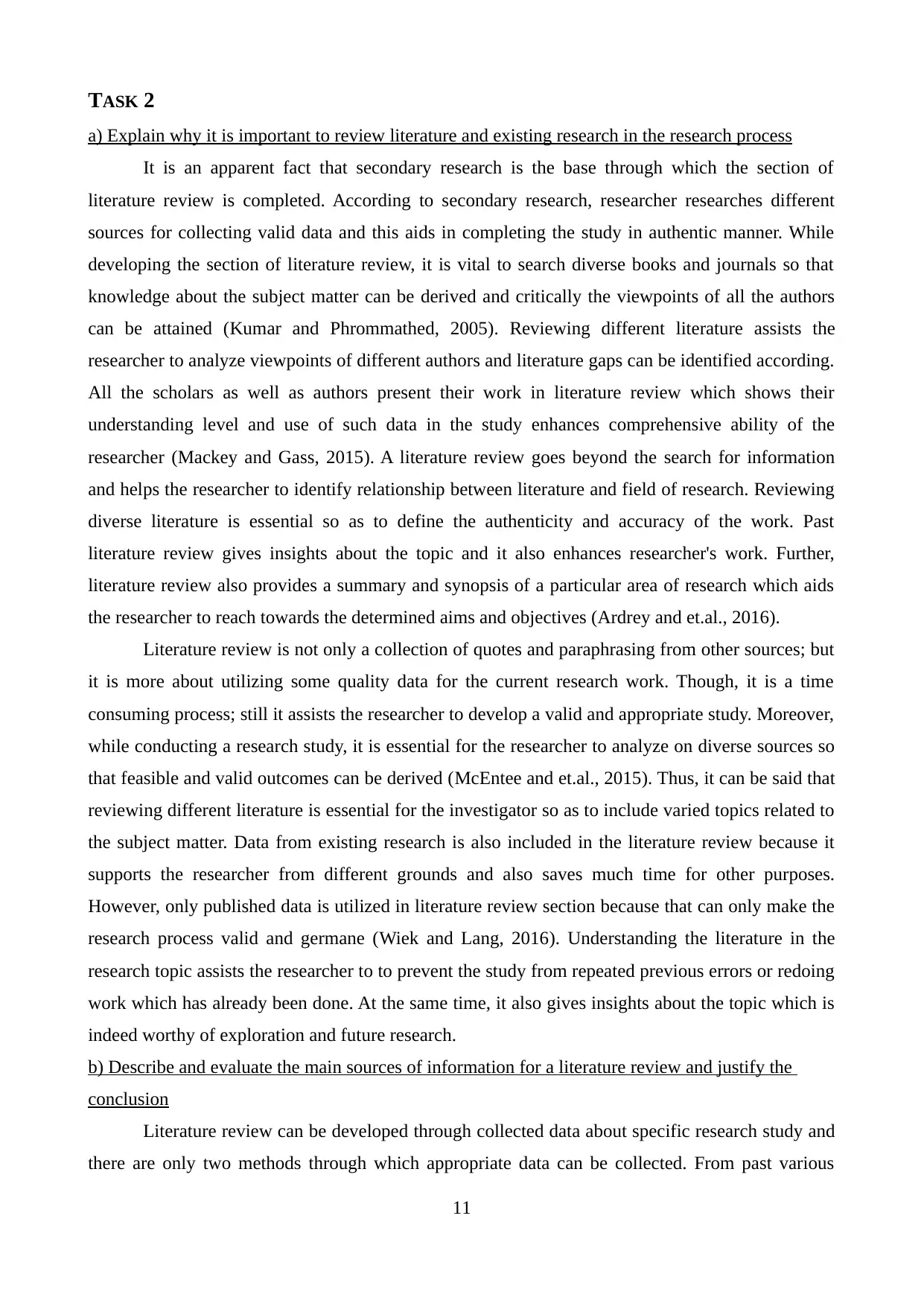
TASK 2
a) Explain why it is important to review literature and existing research in the research process
It is an apparent fact that secondary research is the base through which the section of
literature review is completed. According to secondary research, researcher researches different
sources for collecting valid data and this aids in completing the study in authentic manner. While
developing the section of literature review, it is vital to search diverse books and journals so that
knowledge about the subject matter can be derived and critically the viewpoints of all the authors
can be attained (Kumar and Phrommathed, 2005). Reviewing different literature assists the
researcher to analyze viewpoints of different authors and literature gaps can be identified according.
All the scholars as well as authors present their work in literature review which shows their
understanding level and use of such data in the study enhances comprehensive ability of the
researcher (Mackey and Gass, 2015). A literature review goes beyond the search for information
and helps the researcher to identify relationship between literature and field of research. Reviewing
diverse literature is essential so as to define the authenticity and accuracy of the work. Past
literature review gives insights about the topic and it also enhances researcher's work. Further,
literature review also provides a summary and synopsis of a particular area of research which aids
the researcher to reach towards the determined aims and objectives (Ardrey and et.al., 2016).
Literature review is not only a collection of quotes and paraphrasing from other sources; but
it is more about utilizing some quality data for the current research work. Though, it is a time
consuming process; still it assists the researcher to develop a valid and appropriate study. Moreover,
while conducting a research study, it is essential for the researcher to analyze on diverse sources so
that feasible and valid outcomes can be derived (McEntee and et.al., 2015). Thus, it can be said that
reviewing different literature is essential for the investigator so as to include varied topics related to
the subject matter. Data from existing research is also included in the literature review because it
supports the researcher from different grounds and also saves much time for other purposes.
However, only published data is utilized in literature review section because that can only make the
research process valid and germane (Wiek and Lang, 2016). Understanding the literature in the
research topic assists the researcher to to prevent the study from repeated previous errors or redoing
work which has already been done. At the same time, it also gives insights about the topic which is
indeed worthy of exploration and future research.
b) Describe and evaluate the main sources of information for a literature review and justify the
conclusion
Literature review can be developed through collected data about specific research study and
there are only two methods through which appropriate data can be collected. From past various
11
a) Explain why it is important to review literature and existing research in the research process
It is an apparent fact that secondary research is the base through which the section of
literature review is completed. According to secondary research, researcher researches different
sources for collecting valid data and this aids in completing the study in authentic manner. While
developing the section of literature review, it is vital to search diverse books and journals so that
knowledge about the subject matter can be derived and critically the viewpoints of all the authors
can be attained (Kumar and Phrommathed, 2005). Reviewing different literature assists the
researcher to analyze viewpoints of different authors and literature gaps can be identified according.
All the scholars as well as authors present their work in literature review which shows their
understanding level and use of such data in the study enhances comprehensive ability of the
researcher (Mackey and Gass, 2015). A literature review goes beyond the search for information
and helps the researcher to identify relationship between literature and field of research. Reviewing
diverse literature is essential so as to define the authenticity and accuracy of the work. Past
literature review gives insights about the topic and it also enhances researcher's work. Further,
literature review also provides a summary and synopsis of a particular area of research which aids
the researcher to reach towards the determined aims and objectives (Ardrey and et.al., 2016).
Literature review is not only a collection of quotes and paraphrasing from other sources; but
it is more about utilizing some quality data for the current research work. Though, it is a time
consuming process; still it assists the researcher to develop a valid and appropriate study. Moreover,
while conducting a research study, it is essential for the researcher to analyze on diverse sources so
that feasible and valid outcomes can be derived (McEntee and et.al., 2015). Thus, it can be said that
reviewing different literature is essential for the investigator so as to include varied topics related to
the subject matter. Data from existing research is also included in the literature review because it
supports the researcher from different grounds and also saves much time for other purposes.
However, only published data is utilized in literature review section because that can only make the
research process valid and germane (Wiek and Lang, 2016). Understanding the literature in the
research topic assists the researcher to to prevent the study from repeated previous errors or redoing
work which has already been done. At the same time, it also gives insights about the topic which is
indeed worthy of exploration and future research.
b) Describe and evaluate the main sources of information for a literature review and justify the
conclusion
Literature review can be developed through collected data about specific research study and
there are only two methods through which appropriate data can be collected. From past various
11
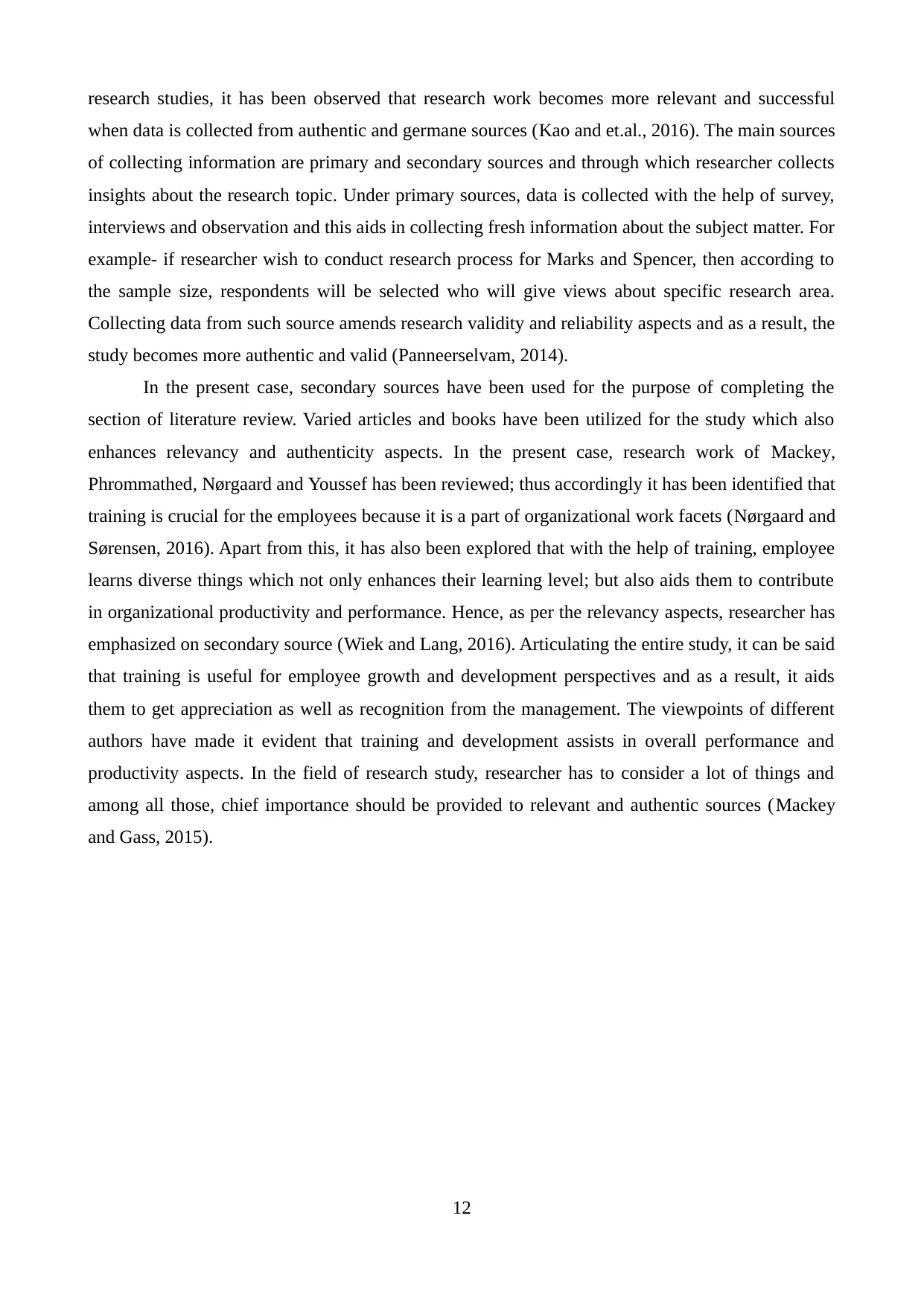
research studies, it has been observed that research work becomes more relevant and successful
when data is collected from authentic and germane sources (Kao and et.al., 2016). The main sources
of collecting information are primary and secondary sources and through which researcher collects
insights about the research topic. Under primary sources, data is collected with the help of survey,
interviews and observation and this aids in collecting fresh information about the subject matter. For
example- if researcher wish to conduct research process for Marks and Spencer, then according to
the sample size, respondents will be selected who will give views about specific research area.
Collecting data from such source amends research validity and reliability aspects and as a result, the
study becomes more authentic and valid (Panneerselvam, 2014).
In the present case, secondary sources have been used for the purpose of completing the
section of literature review. Varied articles and books have been utilized for the study which also
enhances relevancy and authenticity aspects. In the present case, research work of Mackey,
Phrommathed, Nørgaard and Youssef has been reviewed; thus accordingly it has been identified that
training is crucial for the employees because it is a part of organizational work facets (Nørgaard and
Sørensen, 2016). Apart from this, it has also been explored that with the help of training, employee
learns diverse things which not only enhances their learning level; but also aids them to contribute
in organizational productivity and performance. Hence, as per the relevancy aspects, researcher has
emphasized on secondary source (Wiek and Lang, 2016). Articulating the entire study, it can be said
that training is useful for employee growth and development perspectives and as a result, it aids
them to get appreciation as well as recognition from the management. The viewpoints of different
authors have made it evident that training and development assists in overall performance and
productivity aspects. In the field of research study, researcher has to consider a lot of things and
among all those, chief importance should be provided to relevant and authentic sources (Mackey
and Gass, 2015).
12
when data is collected from authentic and germane sources (Kao and et.al., 2016). The main sources
of collecting information are primary and secondary sources and through which researcher collects
insights about the research topic. Under primary sources, data is collected with the help of survey,
interviews and observation and this aids in collecting fresh information about the subject matter. For
example- if researcher wish to conduct research process for Marks and Spencer, then according to
the sample size, respondents will be selected who will give views about specific research area.
Collecting data from such source amends research validity and reliability aspects and as a result, the
study becomes more authentic and valid (Panneerselvam, 2014).
In the present case, secondary sources have been used for the purpose of completing the
section of literature review. Varied articles and books have been utilized for the study which also
enhances relevancy and authenticity aspects. In the present case, research work of Mackey,
Phrommathed, Nørgaard and Youssef has been reviewed; thus accordingly it has been identified that
training is crucial for the employees because it is a part of organizational work facets (Nørgaard and
Sørensen, 2016). Apart from this, it has also been explored that with the help of training, employee
learns diverse things which not only enhances their learning level; but also aids them to contribute
in organizational productivity and performance. Hence, as per the relevancy aspects, researcher has
emphasized on secondary source (Wiek and Lang, 2016). Articulating the entire study, it can be said
that training is useful for employee growth and development perspectives and as a result, it aids
them to get appreciation as well as recognition from the management. The viewpoints of different
authors have made it evident that training and development assists in overall performance and
productivity aspects. In the field of research study, researcher has to consider a lot of things and
among all those, chief importance should be provided to relevant and authentic sources (Mackey
and Gass, 2015).
12
⊘ This is a preview!⊘
Do you want full access?
Subscribe today to unlock all pages.

Trusted by 1+ million students worldwide
1 out of 13
Related Documents
Your All-in-One AI-Powered Toolkit for Academic Success.
+13062052269
info@desklib.com
Available 24*7 on WhatsApp / Email
![[object Object]](/_next/static/media/star-bottom.7253800d.svg)
Unlock your academic potential
Copyright © 2020–2025 A2Z Services. All Rights Reserved. Developed and managed by ZUCOL.





